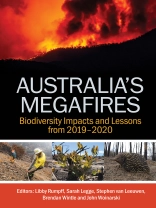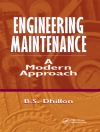The Australian wildfires of 2019–20 (Black Summer) were devastating and unprecedented. These megafires burnt more than 10 million hectares, mostly of forests in southern and eastern Australia. Many of the fires were uncontrollable. These megafires affected many of Australia’s most important conservation areas and severely impacted threatened species and ecological communities. They were a consequence of climate change – and offered a glimpse of how this is likely to continue to affect our future.
Australia’s Megafires includes contributions by more than 200 researchers and managers with direct involvement in the management and conservation of the biodiversity affected by the Black Summer wildfires. It provides a comprehensive review of the impacts of these fires on all components of biodiversity, and on Indigenous cultural values.
These fires also triggered an extraordinary and highly collaborative response by governments, NGOs, Indigenous groups, scientists, landholders and others, seeking to recover the fire-affected species and environments – to restore Country. This book documents that response. It draws lessons that should be heeded to sustain that recovery and to be better prepared for the inevitable future comparable catastrophes. Such lessons are of global relevance, for wildfires increasingly threaten biodiversity and livelihoods across the globe.
विषयसूची
Acknowledgements
List of contributors
1. Introduction
2. The 2019–20 Australian wildfires: precursors, characteristics and implications for the future
3. Impacts of wildfire on Indigenous cultural values
4. Consequences of the Australian 2019–20 wildfires for sites important for biodiversity and other World Heritage values
5. Wildfire effects on soils and soil processes
6. The impact of the 2019–20 Australian wildfires on aquatic systems
7. The impacts of the 2019–20 wildfires on marine species and ecosystems
8. Ecological communities: impact and response
9. Blackened roots and green shoots: emerging trends in decline and recovery in Australian plant species after the 2019–20 wildfires
10. The impacts of the 2019–20 wildfires on Australian fungi
11. Impacts of the 2019–20 wildfires on Australian invertebrates
12. Estimating the number of wild animals affected by Australia’s 2019–20 wildfires
13. The impacts of the 2019–20 wildfires on Australian frogs
14. The impacts of the 2019–20 wildfires on Australia’s lizards and snakes
15. The impacts of the 2019–20 wildfires on Australian birds
16. Impacts of the 2019–20 wildfires on native mammals
17. How introduced animals compound the effects of fire on native plants and animals
18. The compounding impacts of disease and weeds after the 2019–20 wildfires on Australian vascular plants and communities
19. Interacting and compounding impacts: fire and forestry in the 2019–20 wildfires
20. Review of impacts of the 2019–20 wildfires on biodiversity
21. Prescribed burning in Australian forests: characteristics, impacts and effects
22. Response by the Australian Government to the 2019–20 wildfires
23. State agency responses to support biodiversity recovery following the 2019–20 wildfires
24. Immediate and longer-term responses of conservation NGOs to the 2019–20 wildfires
25. Responses of natural resource management groups to biodiversity loss and recovery in the 2019–20 wildfires
26. Wildlife welfare and the 2019–20 wildfires
27. Ex situ responses to the 2019–20 wildfires
28. Shared responsibilities and collaborative responses: review of actions taken to support the recovery of biodiversity after the 2019–20 wildfires
29. What did we learn about biodiversity management, policy and operations from the 2019–20 wildfires?
30. Government inquiries following the 2019–20 wildfires
31. Monitoring impacts and recovery
32. A precautionary tale: the consequences of, and remedies for, data deficiencies and uncertainty in conservation decisions related to the 2019–20 wildfires
33. Empowering Indigenous leadership and participation in wildfire recovery, cultural burning and land management
34. Of grief, spirit and hope: personal reflections of the 2019–20 wildfires
35. Recommendations
36. Our future
Index
लेखक के बारे में
John C. Z. Woinarski is a Professor of Conservation Biology at Charles Darwin University. He has been engaged in research, management and policy relating to Australian biodiversity for over 40 years. He was the author of A Bat’s End (CSIRO Publishing, 2018), a co-author of Cats in Australia (CSIRO Publishing, 2019) and The Action Plan for Australian Lizards and Snakes 2017 (CSIRO Publishing, 2019), and co-editor of Recovering Australian Threatened Species (CSIRO Publishing, 2018).












